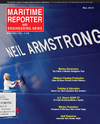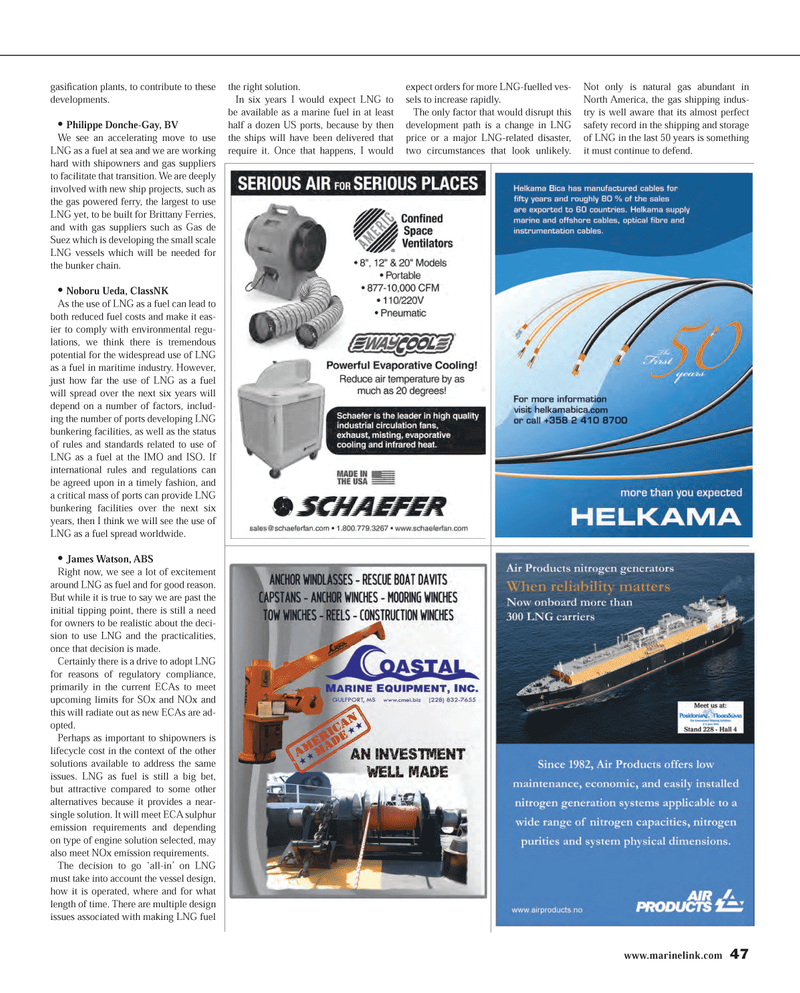
Page 47: of Maritime Reporter Magazine (May 2014)
Marine Electronics Edition
Read this page in Pdf, Flash or Html5 edition of May 2014 Maritime Reporter Magazine
www.marinelink.com 47 gasifi cation plants, to contribute to these developments. Philippe Donche-Gay, BV
We see an accelerating move to use
LNG as a fuel at sea and we are working hard with shipowners and gas suppliers to facilitate that transition. We are deeply involved with new ship projects, such as the gas powered ferry, the largest to use
LNG yet, to be built for Brittany Ferries, and with gas suppliers such as Gas de
Suez which is developing the small scale
LNG vessels which will be needed for the bunker chain. Noboru Ueda, ClassNK
As the use of LNG as a fuel can lead to both reduced fuel costs and make it eas- ier to comply with environmental regu- lations, we think there is tremendous potential for the widespread use of LNG as a fuel in maritime industry. However, just how far the use of LNG as a fuel will spread over the next six years will depend on a number of factors, includ- ing the number of ports developing LNG bunkering facilities, as well as the status of rules and standards related to use of
LNG as a fuel at the IMO and ISO. If international rules and regulations can be agreed upon in a timely fashion, and a critical mass of ports can provide LNG bunkering facilities over the next six years, then I think we will see the use of
LNG as a fuel spread worldwide. James Watson, ABS
Right now, we see a lot of excitement around LNG as fuel and for good reason.
But while it is true to say we are past the initial tipping point, there is still a need for owners to be realistic about the deci- sion to use LNG and the practicalities, once that decision is made.
Certainly there is a drive to adopt LNG for reasons of regulatory compliance, primarily in the current ECAs to meet upcoming limits for SOx and NOx and this will radiate out as new ECAs are ad- opted.
Perhaps as important to shipowners is lifecycle cost in the context of the other solutions available to address the same issues. LNG as fuel is still a big bet, but attractive compared to some other alternatives because it provides a near- single solution. It will meet ECA sulphur emission requirements and depending on type of engine solution selected, may also meet NOx emission requirements.
The decision to go ‘all-in’ on LNG must take into account the vessel design, how it is operated, where and for what length of time. There are multiple design issues associated with making LNG fuel the right solution.
In six years I would expect LNG to be available as a marine fuel in at least half a dozen US ports, because by then the ships will have been delivered that require it. Once that happens, I would expect orders for more LNG-fuelled ves- sels to increase rapidly.
The only factor that would disrupt this development path is a change in LNG price or a major LNG-related disaster, two circumstances that look unlikely.
Not only is natural gas abundant in
North America, the gas shipping indus- try is well aware that its almost perfect safety record in the shipping and storage of LNG in the last 50 years is something it must continue to defend.
MR #5 (42-49).indd 47 5/1/2014 12:15:42 PM

 46
46

 48
48
